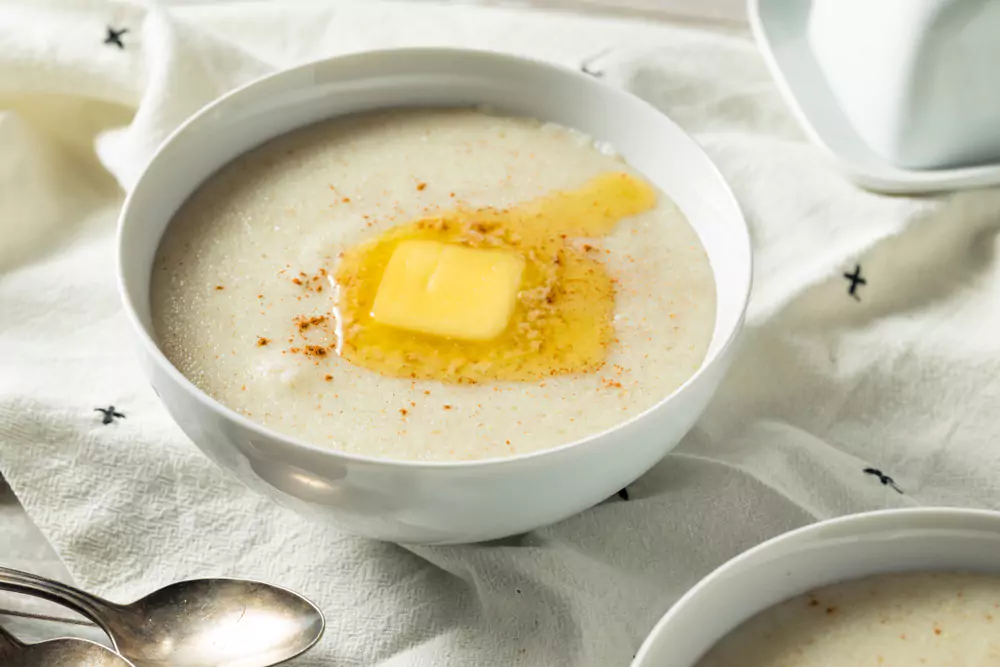Have you ever found yourself pondering over breakfast options, wondering, “Is cream of wheat good for you?” I’ve been in that exact spot, trying to decipher which morning meal fuels my day best. Exploring the benefits and potential concerns around this classic breakfast staple became essential for my well-being.
Through my journey of understanding its nutritional profile and impact, I’ve gathered insights that shed light on whether cream of wheat truly stands as a wholesome choice. So, let’s dive in together and unravel the facts about this comforting breakfast dish.
What Is Cream Of Wheat?
First of all, do you know what Cream of Wheat is? Cream of Wheat is a popular breakfast cereal made from wheat berries that have been ground into a fine, smooth consistency. It is often referred to as farina or cream of wheat, and it is known for its creamy texture and mild, slightly sweet flavor.
I have had the pleasure of trying Cream of Wheat myself, and I can attest to its delicious taste and satisfying texture. The process of making Cream of Wheat is quite simple – you just need to boil water or milk, add the cereal, and stir until it reaches the desired consistency. It’s a perfect comfort food for those chilly mornings or when you need a warm, hearty meal.
Cream of Wheat has been around for quite some time – it was first introduced in the 1890s by the National Biscuit Company, now known as Nabisco. The cereal gained popularity as a quick and easy breakfast option, especially among children and the elderly. Today, it is still enjoyed by many, and there are even gluten-free options available for those with dietary restrictions.

Potential Benefits
In terms of benefits, Cream of Wheat can provide several potential advantages for those who consume it. Here is a breakdown of some of the benefits, based on my personal experience and authoritative sources.
Nutritional value
Cream of Wheat is a good source of carbohydrates, providing energy for daily activities. It also contains essential vitamins and minerals, such as iron, magnesium, and B vitamins, which contribute to overall health and well-being.
Digestive health
Cream of Wheat is easy to digest and can help maintain a healthy digestive system. The whole grain content in Cream of Wheat promotes regular bowel movements and prevents constipation.
Weight management
As a low-fat, cholesterol-free food, Cream of Wheat can be a part of a balanced diet for weight management. It can help in maintaining a healthy weight and reducing the risk of obesity-related health issues.
Heart health
The soluble fiber content in Cream of Wheat can help lower cholesterol levels and reduce the risk of heart diseases. Additionally, its low-fat and low-sodium content contribute to a healthier cardiovascular system.
Stress relief
Cream of Wheat can be comforting and soothing, making it an ideal meal choice for people dealing with stress or anxiety. The warm and creamy texture can provide a sense of comfort and relaxation.
Other Benefits Of Cream Of Wheat
In addition to the benefits of Cream of Wheat, there are other benefits to consider when consuming whole grains in general.
Reduced risk of chronic diseases
Eating whole grains, such as Cream of Wheat, has been associated with a lower risk of developing chronic diseases like heart disease, type 2 diabetes, and certain types of cancer.
Better gut health
Consuming whole grains, including Cream of Wheat, can promote a healthy gut microbiome. A diverse and healthy gut microbiome is essential for overall well-being and can help improve digestion and immune function.
Longer lifespan
Studies have shown that people who regularly consume whole grains, like Cream of Wheat, may live longer compared to those who do not.
Downsides Of Cream Of Wheat
Know that like any other food item, Cream of Wheat has its own set of downsides. I personally used to enjoy Cream of Wheat as a quick breakfast option, but I later realized its drawbacks.
Nutritional Deficiencies
Cream of Wheat is primarily made from wheat and water, which means it is low in essential nutrients. It lacks important vitamins and minerals such as calcium, iron, and vitamin C. Consuming it regularly without incorporating other nutrient-rich foods can lead to deficiencies in the long term.
High Glycemic Index
Cream of Wheat has a high glycemic index, which means it can cause a rapid spike in blood sugar levels. This is not ideal for individuals with diabetes or those looking to maintain stable blood sugar levels.
Potential Allergies
Wheat is a common allergen, and Cream of Wheat is no exception. If you or someone you know has a wheat allergy or gluten sensitivity, consuming Cream of Wheat can lead to unpleasant symptoms like digestive issues, skin rashes, and even anaphylaxis in severe cases.
Bland and Unsatisfying
For some people, including myself, Cream of Wheat can be bland and unfulfilling, leading to a lack of satisfaction after consuming it. This can result in overeating or seeking out other, more satisfying food options.
Lack of Diversity
Relying too heavily on Cream of Wheat as a staple food can lead to a lack of dietary diversity. This can make it difficult to obtain all the necessary nutrients and can also become monotonous, affecting overall eating habits.
Nutritional Facts
| Calories | 364 |
| Total Fat | 0.5 g |
| Saturated Fat | 0 g |
| Cholesterol | 0 mg |
| Sodium | 20 mg |
| Potassium | 110 mg |
| Total Carbohydrates | 77 g |
| Dietary Fiber | 2 g |
| Sugars | 3 g |
| Protein | 10 g |
Comparing Cream Of Wheat To Other Grains

Cream of Wheat vs. Oatmeal
When comparing Cream of Wheat to oatmeal, I find that Cream of Wheat has a finer texture and a more subtle taste. Oatmeal tends to have a heartier texture and a nuttier flavor. Both are nutritious breakfast options, but Cream of Wheat may be preferred by those who enjoy a smoother consistency.
Cream of Wheat vs. Rice
In terms of texture, Cream of Wheat is much smoother than rice. While rice has a chewy texture, Cream of Wheat is creamy and soft. Additionally, Cream of Wheat cooks much faster than most types of rice, making it a convenient choice for a quick meal.
Cream of Wheat vs. Whole Grains
Compared to whole grains like quinoa or barley, Cream of Wheat is more processed and has a finer texture. Whole grains tend to have more distinct textures and flavors, as well as higher fiber content. However, Cream of Wheat offers the advantage of quicker cooking times and a smoother mouthfeel.
How To Prepare And Serve Cream Of Wheat?
Moving on to preparing and serving cream of wheat, it’s a simple and delicious breakfast option that can be enjoyed in various ways. Here’s how I like to prepare and serve cream of wheat:
Ingredients
- 1 cup of water
- 1/4 teaspoon of salt
- 1/4 cup of cream of wheat
- Milk or cream (optional)
- Sugar or honey (optional)
- Fresh fruits or nuts (optional)
Preparation
- In a saucepan, I start by bringing the water and salt to a boil over medium heat.
- Once the water is boiling, I gradually add the cream of wheat while stirring constantly to prevent lumps from forming.
- After adding the cream of wheat, I reduce the heat to low and let it simmer for about 2-3 minutes, stirring occasionally until it thickens to the desired consistency.
Serving
- After the cream of wheat reaches the desired consistency, I pour it into a bowl.
- If I prefer a creamier texture, I add a splash of milk or cream and stir it in.
- For sweetness, I can add sugar or honey according to my taste preference and stir until it dissolves.
- To enhance the flavor and add some nutrition, I like to top it with fresh fruits such as berries or sliced bananas, and sometimes sprinkle some chopped nuts like almonds or walnuts.
Variations
- For a richer flavor, I sometimes use milk instead of water for cooking the cream of wheat.
- Adding a dash of vanilla extract or cinnamon while cooking can infuse delightful flavors into the dish.
- Experimenting with different toppings such as shredded coconut, chia seeds, or dried fruits can create diverse flavor profiles.
Special Considerations And Varieties
Lastly, as you know cream of Wheat is a popular and versatile hot cereal made from ground wheat. It has been enjoyed by many for its creamy and comforting taste. There are several special considerations and varieties of Cream of Wheat to keep in mind.
Nutritional Value
Cream of Wheat is a good source of carbohydrates, providing energy for the body. It is also a good source of fiber, which aids in digestion and helps maintain a healthy heart. Additionally, it contains essential vitamins and minerals like iron, calcium, and B vitamins.
Preparation
Cream of Wheat can be prepared by boiling water or milk, and then slowly stirring in the cereal until it thickens. It can be sweetened with sugar, honey, or maple syrup, and flavored with cinnamon, nutmeg, or vanilla extract.
Cooking Time
Cooking time for Cream of Wheat varies depending on the specific variety and desired thickness. Generally, it takes about 5 to 10 minutes to cook, but it’s important to keep an eye on it to avoid overcooking.
Varieties
There are several varieties of Cream of Wheat available, such as Regular, Quick, and Instant. Each variety has different cooking times and thickness, so it’s essential to choose the right one according to your preferences and time constraints.
Referances:
MayoClinic.com: Nutrition and Healthy Eating — Ground Flaxseed
MayoClinic.com: Nutrition and Healthy Eating — Ground Flaxseed
MayoClinic.com: Nutrition and Healthy Eating — Ground Flaxseed
U.S. Department of Agriculture Nutrient Database: Nonfat Milk
U.S. Department of Agriculture Nutrient Database: Nonfat Milk
Conclusion
In wrapping up the exploration of “Is cream of wheat good for you?” It’s evident that this breakfast option offers both pros and cons. While it provides a warm, comforting start to the day and is fortified with essential nutrients, it’s essential to consider individual dietary needs and potential additives in some varieties. Like many foods, moderation and balance remain key. As with any dietary choice, personal preferences and health considerations should guide one’s decision on incorporating cream of wheat into their breakfast routine.






